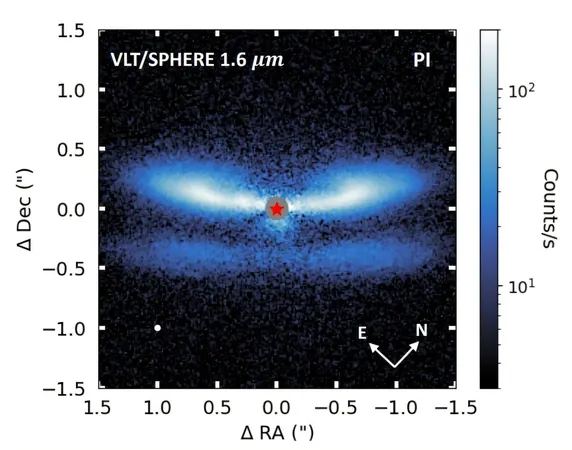
Astronomers Unveil Secret Features of the Icy Protoplanetary Disk Surrounding Star PDS 453!
2024-11-13
Author: Mei
Groundbreaking Study on Protoplanetary Disks
In a groundbreaking study, an international team of astronomers has utilized the European Southern Observatory's (ESO) Very Large Telescope (VLT) to closely examine the icy protoplanetary disk surrounding the young star PDS 453. This investigation, recently published on the preprint server arXiv, provides pivotal insights into the structure and composition of protoplanetary disks, which are critical in understanding planetary formation.
Significance of Protoplanetary Disks
Protoplanetary disks are the birthplace of planets, extending across vast regions of space and containing various materials essential for forming celestial bodies. Researchers believe the chemical processes that occur within these disks play a crucial role in determining the eventual composition of the planets that form from them. By studying early disk formation phases, scientists can enhance their understanding of how planets, planetoids, and other astronomical entities evolve over time.
Details About Star PDS 453
Located approximately 424 light-years away in the Scorpius-Centaurus OB association, PDS 453 is an intermediate-mass F-type star estimated to be around 5 million years old. It occupies a unique position in its stellar lifecycle, bridging the gap between low-mass T Tauri stars and more advanced Herbig Ae stars.
Observational Breakthroughs
The protoplanetary disk around PDS 453 was first identified in 2006 and is notable for its edge-on orientation, which features a sharply defined outer edge, possibly shaped by the gravitational influence of a nearby companion star. Initial observations have already revealed the presence of water ice in the disk's upper layers, a finding that piqued the interest of astronomers seeking to learn more about its composition.
Detailed Examination Using Advanced Instruments
Recently, Laurine Martinien from Grenoble Alpes University led a team that employed the VLT's Spectro-Polarimetric High-contrast Exoplanet REsearch (SPHERE) instrument to conduct a detailed examination of this fascinating disk. Their research was further bolstered by data from the Hubble Space Telescope's Near Infrared Camera and Multi-Object Spectrometer (NICMOS).
Key Findings of the Research
In their paper, the researchers noted, "We present archival HST/NICMOS and new VLT/SPHERE data, providing the sharpest and highest contrast image of the disk to date." The high-resolution observations revealed that the disk of PDS 453 has a distinctly inclined morphology, featuring two reflection nebulae. It extends from nearly the stellar surface to around 160 astronomical units (AU) away, with a dramatic transition occurring at about 70 AU, resembling a ring-like structure. The disk’s inclination is measured at a striking 80 degrees.
Composition Analysis
The findings suggest that PDS 453's disk is a unique configuration where our line of sight to the star skims across the disk's upper surface. Analysis indicates that water ice constitutes about 10% of the inner disk and 20% of the outer disk by volume—values that align with observations from disks of various inclinations.
Future Research Directions
In light of these discoveries, the researchers emphasize the need for further observations using advanced instruments like the James Webb Space Telescope (JWST) and the Atacama Large Millimeter/submillimeter Array (ALMA) to refine the understanding of this remarkable protoplanetary disk.
Conclusion
Stay tuned for more astonishing revelations from the universe as astronomers continue to peel back the layers of cosmic secrets surrounding young stars!




 Brasil (PT)
Brasil (PT)
 Canada (EN)
Canada (EN)
 Chile (ES)
Chile (ES)
 Česko (CS)
Česko (CS)
 대한민국 (KO)
대한민국 (KO)
 España (ES)
España (ES)
 France (FR)
France (FR)
 Hong Kong (EN)
Hong Kong (EN)
 Italia (IT)
Italia (IT)
 日本 (JA)
日本 (JA)
 Magyarország (HU)
Magyarország (HU)
 Norge (NO)
Norge (NO)
 Polska (PL)
Polska (PL)
 Schweiz (DE)
Schweiz (DE)
 Singapore (EN)
Singapore (EN)
 Sverige (SV)
Sverige (SV)
 Suomi (FI)
Suomi (FI)
 Türkiye (TR)
Türkiye (TR)
 الإمارات العربية المتحدة (AR)
الإمارات العربية المتحدة (AR)